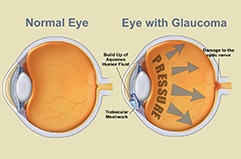
This is your website preview.
Currently it only shows your basic business info. Start adding relevant business details such as description, images and products or services to gain your customers attention by using Boost 360 android app / iOS App / web portal.
Glaucoma is often called as Silent Thief of Vision because people usually do not notice any sign of the disease until they have already lost significant vision. Once lost, vision cannot be restored. What is Glaucoma: Glaucoma is an eye disease that causes loss of vision by damaging the optic nerve. This nerve sends signal from your eye to the brain. This condition most of the time is associated with increased intraocular pressure. Initially peripheral vision gets affected. Over time as it advances central vision also get involved. You may not notice a loss of peripheral vision ( Side vision ) until you have a lost great deal of your sight. What are the different types of Glaucoma? Chronic ( Open angle ) Glaucoma: This is the most common type. Aqueous fluid drains too slowly and pressure inside the eye buildup. It usually result from aging of the drainage channel which does not work as well over time. However younger people can also get this type of Glaucoma. Acute Angle closure Glaucoma It is less common. It causes sudden rise in intraocular pressure requiring immediate emergency medical care. Patient suddenly experience blurred vision, severe headache, eye pain, nausea, vomiting or seeing rainbow like halos around lights. Occasionally the condition may be without symptoms. Normal Tension Glaucoma : This is a form of open angle Glaucoma not related to high pressure. These people may be unusually sensitive to normal intraocular pressure. Reduced blood circulation to the optic nerve may also play a role in normal tension Glaucoma. Secondary Glaucoma : Glaucoma that develops due to other conditions or diseases. These includes diabetes, leukemia & sickle cell anemia, arthritis, cataract, eye injuries, eye inflammations , steroids, growth of unhealthy blood vessels. Post Surgical Glaucoma Cataract surgery, Retinal surgery Risk Factor of Glaucoma Age : Older you are grater the risk Race : African, American have Glaucoma four to five times more often than other. They also likely to have Glaucoma at younger age Family History : You are more likely to get Glaucoma if your blood relations are suffering. If you have Glaucoma , your family members should get complete eye examination. Medical History : Diabeties, previous eye injury, eye surgery, long term use of steroids increases risk of Glaucoma. Three Major Signs of Glaucoma Optic nerve damage. Visual field loss. Increased intraocular pressure. How Does Glaucoma Damage Our Eye? For understanding Glaucoma and damage produced by it firstly we should know water fluid (aqueous humor) circulation in our eyes. Aqueous humor is produced by the ciliary body behind the iris . It flows through the pupil into anterior chamber. From anterior chamber it drains out into the bloodstream at the angle between iris and cornea. For some people , fluid cant drain properly because of a faulty drainage system . This drainage system may get slow down as your age advances. Because of this, aqueous humor (fluid) get accumulated inside the eye and the pressure inside the eye builds up. This increased intraocular pressure gradually damages the optic nerve fibers which are essential for vision. For others, glaucoma damages the optic nerve fibers without increased intraocular pressure. This is called as normal tension Glaucoma. These peoples may be unusually sensitive even to normal levels of pressure. Their Glaucoma may also be related to problem with blood flow in the eye. Usually Glaucoma affets side vision (peripheral ) first. Late in the disease, Glaucoma causes tunnel vision ( looking through a pipe ). In this condition the person can only see straight ahead. That’s why someone with Glaucoma can have good straight ahead ( central ) vision . However even central vision can be seriously damaged. Investigation : Tonometry : It measures pressure inside the eye Pachymetry : It measures thickness of cornea which may affect pressure reading and the risk of Glaucoma progression. Opthalmoscopy : It inspect the optic nerve at the back of the eye Gonioscopy : It inspect the angle between cornea and iris Perimetry : It eveluates your visual field. Photagraphy : Laser scanning. It shows appearance of the optic nerve Treatment Glaucoma can usually be treated & controlled using Medicines Laser Surgery Glaucoma surgery Combination of these treatments Medicines lower pressure inside the eye. Often people with Glaucoma have to take these medicines for life to control the pressure and to limit vision loss. Glaucoma surgery creates a new path through the eye tissue to let fluid drain from eye. Discuss with your ophthalmologist about treatment. Weather medicine will help you or you will have to undergo glaucoma surgery
We Provide Best Medical Service
Online appointment booking is not available right now.
Appointment Confirmed
Your appointment ID is
| Doctor Name: | |
| Date & Time: | |
| Contact: | +918048128158 |
| Address: | Sujay Netra Seva,Opp.Neharu Garden,Shalimar |
| Appointment fee: | |
| Payment mode: | |
| Join video call at: |
Thanks for choosing us.Your appointment details has been shared on your mobile number as well. Please arrive atleast 10 minutes ahead of the scheduled time.
Success

